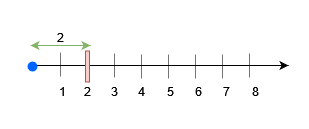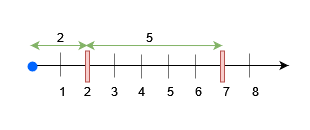Block Placement Queries
HardUpdated: Aug 2, 2025
Practice on:
Problem
There exists an infinite number line, with its origin at 0 and extending towards the positive x-axis.
You are given a 2D array queries, which contains two types of queries:
- For a query of type 1,
queries[i] = [1, x]. Build an obstacle at distancexfrom the origin. It is guaranteed that there is no obstacle at distancexwhen the query is asked. - For a query of type 2,
queries[i] = [2, x, sz]. Check if it is possible to place a block of sizeszanywhere in the range[0, x]on the line, such that the block entirely lies in the range[0, x]. A block cannot be placed if it intersects with any obstacle, but it may touch it. Note that you donot actually place the block. Queries are separate.
Return a boolean array results, where results[i] is true if you can place the block specified in the ith query of type 2, and false otherwise.
Examples
Example 1
Input: queries = [[1,2],[2,3,3],[2,3,1],[2,2,2]]
Output: [false,true,true]
Explanation:
 For query 0, place an obstacle at
For query 0, place an obstacle at x = 2. A block of size at most 2 can be placed before x = 3.
Example 2
Input: queries = [[1,7],[2,7,6],[1,2],[2,7,5],[2,7,6]]
Output: [true,true,false]
Explanation:

- Place an obstacle at
x = 7for query 0. A block of size at most 7 can be placed beforex = 7. - Place an obstacle at
x = 2for query 2. Now, a block of size at most 5 can be placed beforex = 7, and a block of size at most 2 beforex = 2.
Constraints
1 <= queries.length <= 15 * 10^42 <= queries[i].length <= 31 <= queries[i][0] <= 21 <= x, sz <= min(5 * 104, 3 * queries.length)- The input is generated such that for queries of type 1, no obstacle exists at distance
xwhen the query is asked. - The input is generated such that there is at least one query of type 2.
Solution
Method 1 – Ordered Set (Binary Search Tree)
Intuition
To efficiently insert obstacles and answer range queries, we maintain a sorted set of obstacle positions. For each type 2 query, we check all intervals between obstacles (including 0 and x as boundaries) to see if any interval can fit the block.
Approach
- Use a balanced BST or ordered set to store obstacle positions.
- For each query:
- If type 1, insert x into the set.
- If type 2, find all obstacles in [0, x] and check the gaps between consecutive obstacles (including 0 and x as boundaries).
- For each gap, if the interval is at least sz, return true for this query.
- Collect results for all type 2 queries.
Code
C++
#include <set>
class Solution {
public:
vector<bool> blockPlacementQueries(vector<vector<int>>& queries) {
set<long long> obs;
vector<bool> ans;
for (auto& q : queries) {
if (q[0] == 1) {
obs.insert(q[1]);
} else {
long long x = q[1], sz = q[2];
obs.insert(-1); obs.insert(x+1);
auto it = obs.lower_bound(0);
long long prev = -1;
bool ok = false;
while (it != obs.end() && *it <= x+1) {
if (*it - prev - 1 >= sz) ok = true;
prev = *it;
++it;
}
obs.erase(-1); obs.erase(x+1);
ans.push_back(ok);
}
}
return ans;
}
};
Go
func blockPlacementQueries(queries [][]int) []bool {
import "sort"
obs := []int{}
ans := []bool{}
for _, q := range queries {
if q[0] == 1 {
obs = append(obs, q[1])
} else {
x, sz := q[1], q[2]
tmp := append(obs[:], 0, x+1)
sort.Ints(tmp)
ok := false
for i := 1; i < len(tmp); i++ {
if tmp[i]-tmp[i-1]-1 >= sz {
ok = true
break
}
}
ans = append(ans, ok)
}
}
return ans
}
Java
import java.util.*;
class Solution {
public List<Boolean> blockPlacementQueries(int[][] queries) {
TreeSet<Integer> obs = new TreeSet<>();
List<Boolean> ans = new ArrayList<>();
for (int[] q : queries) {
if (q[0] == 1) {
obs.add(q[1]);
} else {
int x = q[1], sz = q[2];
obs.add(-1); obs.add(x+1);
Integer prev = -1;
for (Integer pos : obs.tailSet(0)) {
if (pos > x+1) break;
if (pos - prev - 1 >= sz) {
ans.add(true);
break;
}
prev = pos;
}
if (ans.size() < queries.length && (ans.isEmpty() || !ans.get(ans.size()-1))) ans.add(false);
obs.remove(-1); obs.remove(x+1);
}
}
return ans;
}
}
Kotlin
class Solution {
fun blockPlacementQueries(queries: Array<IntArray>): List<Boolean> {
val obs = sortedSetOf<Int>()
val ans = mutableListOf<Boolean>()
for (q in queries) {
if (q[0] == 1) {
obs.add(q[1])
} else {
val x = q[1]
val sz = q[2]
obs.add(-1); obs.add(x+1)
var prev = -1
var ok = false
for (pos in obs.tailSet(0)) {
if (pos > x+1) break
if (pos - prev - 1 >= sz) ok = true
prev = pos
}
obs.remove(-1); obs.remove(x+1)
ans.add(ok)
}
}
return ans
}
}
Python
class Solution:
def blockPlacementQueries(self, queries: list[list[int]]) -> list[bool]:
import bisect
obs = []
ans = []
for q in queries:
if q[0] == 1:
bisect.insort(obs, q[1])
else:
x, sz = q[1], q[2]
tmp = [0] + obs + [x+1]
tmp = [p for p in tmp if p <= x+1]
ok = False
for i in range(1, len(tmp)):
if tmp[i] - tmp[i-1] - 1 >= sz:
ok = True
break
ans.append(ok)
return ans
Rust
impl Solution {
pub fn block_placement_queries(queries: Vec<Vec<i32>>) -> Vec<bool> {
let mut obs = vec![];
let mut ans = vec![];
for q in queries {
if q[0] == 1 {
obs.push(q[1]);
obs.sort();
} else {
let x = q[1];
let sz = q[2];
let mut tmp = vec![0];
tmp.extend(&obs);
tmp.push(x+1);
tmp.retain(|&p| p <= x+1);
let mut ok = false;
for i in 1..tmp.len() {
if tmp[i] - tmp[i-1] - 1 >= sz {
ok = true;
break;
}
}
ans.push(ok);
}
}
ans
}
}
Complexity
- ⏰ Time complexity:
O(q log q)per query due to sorting/insertions. - 🧺 Space complexity:
O(q)— For storing obstacles.